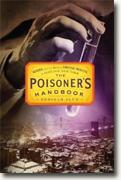The Poisoner's Handbook
Deborah Blum
book reviews:
· general fiction
· chick lit/romance
· sci-fi/fantasy
· graphic novels
· nonfiction
· audio books
· author interviews
· children's books @
curledupkids.com
· DVD reviews @
curledupdvd.com
newsletter
win books
buy online
links
home
for authors
& publishers
for reviewers

 |
The Poisoner's Handbook: Murder and the Birth of Forensic Medicine in Jazz Age New York Deborah Blum The Penguin Press Hardcover 336 pages February 2010 |
|
“Arsenic, cyanide - dirty deeds and they’re done dirt cheap!” That paraphrased quote from AC/DC’s song “Dirty Deeds” could have had relevance in the Jazz Age-era New York that author Deborah Blum writes about in The Poisoner's Handbook
Even when someone came right out and confessed to committing murders involving poisons, it didn’t guarantee a conviction in court. An example is Fredrich Mors (who changed his last name to “Mors” because it means “Death”), who walked into a police station and confessed to killing eight elderly people at the German Odd Fellows home in Yonkers where he worked as an orderly, the first with arsenic and the rest with chloroform. Expert testimony often conflicted, and many poisons could be purchased in any drugstore. Chloroform, for one, was considered to be safe by almost everyone - except people like the police, who knew too well that when robbers used it on their victims, sometimes they never woke up. Blum writes: “Every drugstore stocked it; most doctors, barring a few wary holdouts, prescribed it in abundance. It was mixed into cough syrups and liniments; it was dispensed as a sedative, a sleep aid, a painkiller, a treatment for alcoholic DTs, for hiccupping, seasickness, colic, vomiting, and diarrhea. No one was exactly sure how it worked, just that it appeared to slow the body down, and sedate the brain, sliding a patient into a much-desired stupor.”There were ways to determine if a person had been poisoned by using chloroform, but not all doctors and coroners were aware of this fact. Even when knowledge existed about chloroform and other poisons, and which organs the various poisons would concentrate in and how the organs were affected, etc., there wasn’t a widespread promulgation of that knowledge. Norris and Gettler developed many tests themselves, using organs from the bodies of victims of various poisons through accidents, suicide, or murder to do so. Only when lethal dosages and the effects of poisons on the organs of the body had been determined would toxicology become a legitimate science and prosecutions be successfully carried out. The Poisoner's Handbook Anyone who likes to read about forensic science, true crime stories, and detective novels should enjoy this book immensely. Copious notes at the conclusion of the main contents of the book are interesting in their own right and show that Deborah Blum did her research well. With The Poisoner's Handbook Originally published on Curled Up With A Good Book at www.curledup.com. © Douglas R. Cobb, 2010 |
|
|
|
 Click here to learn more about this month's sponsor! |
|
| fiction · sf/f · comic books · nonfiction · audio newsletter · free book contest · buy books online review index · links · · authors & publishers reviewers |
|
| site by ELBO Computing Resources, Inc. | |
 In the opening chapter, entitled “Chloroform,” readers learn that prior to Norris’s appointment, the previous city coroner, Patrick Riordan, often showed up for work “sodden drunk.” That incompetent man took bribes to state that the cause of death in some cases was suicide rather than murder. Coroners could “bill the city for every body they examined,” and “one assistant coroner ‘investigated’ the same drowning victim more than a dozen times, claiming each time that it had bobbed up at a different location on the Hudson River.” Coroners also earned extra income by such practices as selling “fake birth certificates” and covering up “murders, criminal abortions, and suicides.”
In the opening chapter, entitled “Chloroform,” readers learn that prior to Norris’s appointment, the previous city coroner, Patrick Riordan, often showed up for work “sodden drunk.” That incompetent man took bribes to state that the cause of death in some cases was suicide rather than murder. Coroners could “bill the city for every body they examined,” and “one assistant coroner ‘investigated’ the same drowning victim more than a dozen times, claiming each time that it had bobbed up at a different location on the Hudson River.” Coroners also earned extra income by such practices as selling “fake birth certificates” and covering up “murders, criminal abortions, and suicides.”